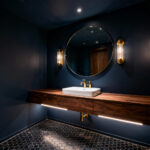Have you ever stepped into a small living room and felt a sense of confinement, as though the walls were closing in? Lighting can be transformative, breathing new life into even the most compact spaces. Imagine a cozy nook bathed in a warm, inviting glow, where every corner radiates comfort and tranquility. This is the power of thoughtful lighting design – it can elevate a room from mere functionality to an oasis of relaxation and rejuvenation.
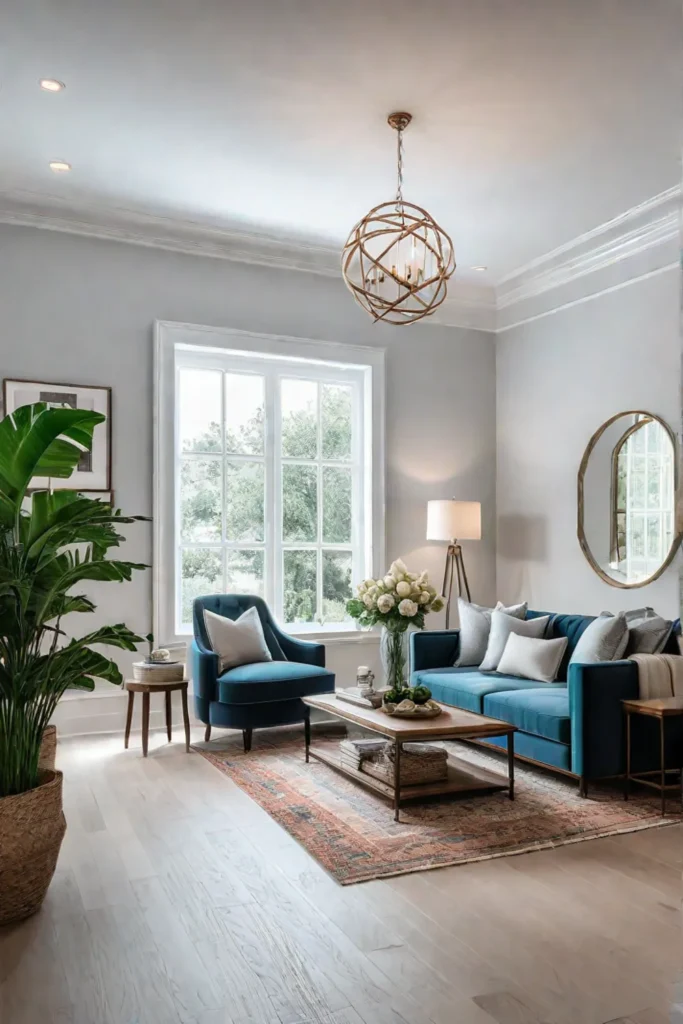
In interior design, lighting is often called the “jewelry” that adorns a space. Just as a well-chosen accessory can accentuate one’s style, carefully curated lighting can enhance the character and ambiance of a living room, no matter its size. Through the strategic interplay of natural and artificial illumination, reflective surfaces, and thoughtful fixture selection, even the most diminutive of spaces can be transformed into a sanctuary that feels open, airy, and inviting.
Harnessing the Power of Natural Light
Natural light is an invaluable ally in small living rooms. Not only does it create a sense of openness and spaciousness, but it also profoundly impacts our well-being. As the renowned architect Frank Lloyd Wright once said, “Light is the breath of a room.” By strategically positioning furniture and window treatments, you can harness the full potential of this precious resource.
One of the simplest yet most effective ways to amplify natural light is through mirrors. Strategically placed opposite windows, mirrors act as reflectors, bouncing and dispersing light throughout the space. This optical illusion creates the perception of depth, instantly making a room feel more expansive. Sheer or translucent window treatments are another excellent choice, allowing sunlight to filter in while maintaining privacy.
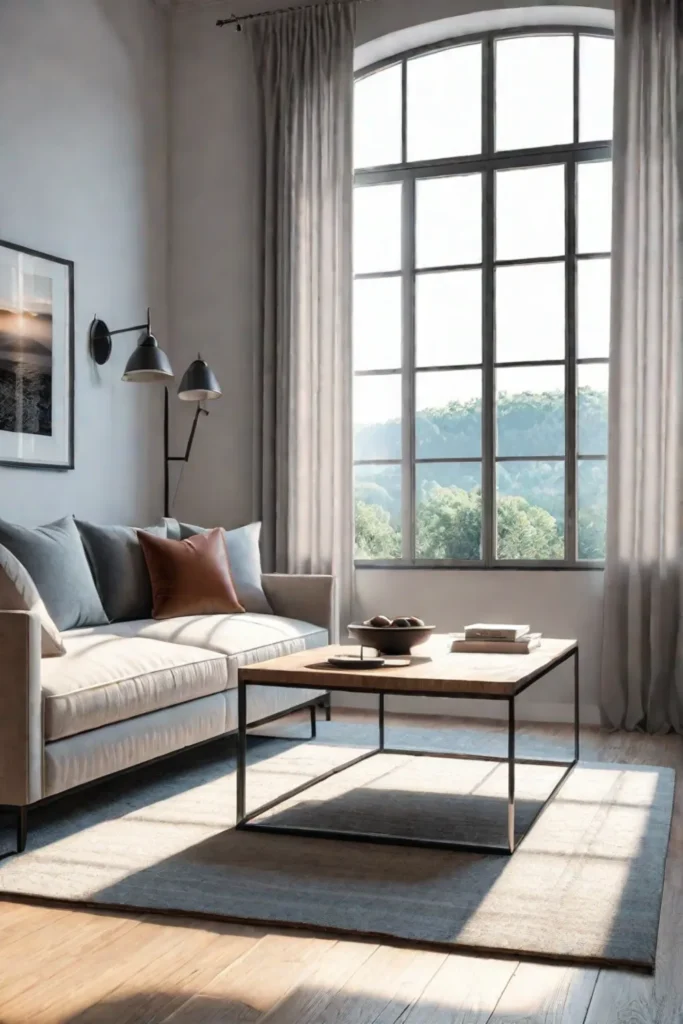
In addition to enhancing the sense of space, natural light has been scientifically proven to improve mood, productivity, and overall well-being. By embracing this free and abundant resource, you can create a living room that looks beautiful and promotes a sense of serenity and rejuvenation.
Layering Artificial Illumination
While natural light is undoubtedly the star of the show, a well-designed artificial lighting plan is crucial for creating a warm, inviting, and functional small living room. The key lies in layering – incorporating multiple light sources to create depth, dimension, and versatility.
Imagine a cozy reading nook illuminated by a soft, dimmable floor lamp, complemented by recessed ceiling lights that provide ambient illumination. Strategically placed accent lighting can highlight architectural features or artwork, adding visual interest and drawing the eye upward, creating the illusion of height. This layered approach not only enhances the aesthetics of the space but also caters to different activities and moods.

When selecting light fixtures, balancing functionality and visual appeal is essential. Oversized fixtures can overwhelm a small living room, making it feel cramped and cluttered. Instead, opt for proportionate pieces that seamlessly integrate into the overall design. Flush-mount or semi-flush ceiling lights are excellent choices, providing ample illumination without dominating the space.
Consider incorporating energy-efficient and sustainable lighting options, such as LED bulbs. Not only do they contribute to a greener lifestyle, but they also offer long-lasting performance and long-term cost savings.
Enhancing Ambiance with Lighting
Lighting creates a warm, inviting, visually appealing atmosphere in a small living room. By layering light sources and utilizing dimmable fixtures, you can control the mood and ambiance, transforming the space from a vibrant gathering place to a cozy, intimate retreat.

Imagine a cozy seating area illuminated by a combination of floor lamps, table lamps, and recessed lighting, each contributing to a warm, diffused glow. Soft, dimmable lighting creates a calming and relaxing ambiance and allows for greater control over the overall atmosphere. Accent lighting, strategically placed to highlight architectural features or artwork, adds visual interest and depth, drawing the eye upward and creating the illusion of height.
Furthermore, the strategic placement and selection of light fixtures can help define different zones within a small living room, creating a sense of flow and purpose. For example, a well-lit reading nook or work area can be carved out, while a dimly lit seating arrangement invites relaxation and conversation.

By carefully curating the lighting scheme, you can transform a small living room into a multifunctional space that caters to various moods and activities while maintaining a cohesive and visually appealing design.
Brightening with Reflective Surfaces
In addition to lighting fixtures, the strategic use of reflective surfaces can significantly enhance a small living room’s brightness and perceived size. Mirrors, metallic accents, and high-gloss finishes act as light multipliers, bouncing and dispersing illumination throughout the space.
A well-placed mirror can work wonders in a compact living room. Consider positioning a large mirror opposite a window, reflecting natural light and creating the illusion of depth. This simple yet effective technique instantly makes a room feel more expansive and airy.
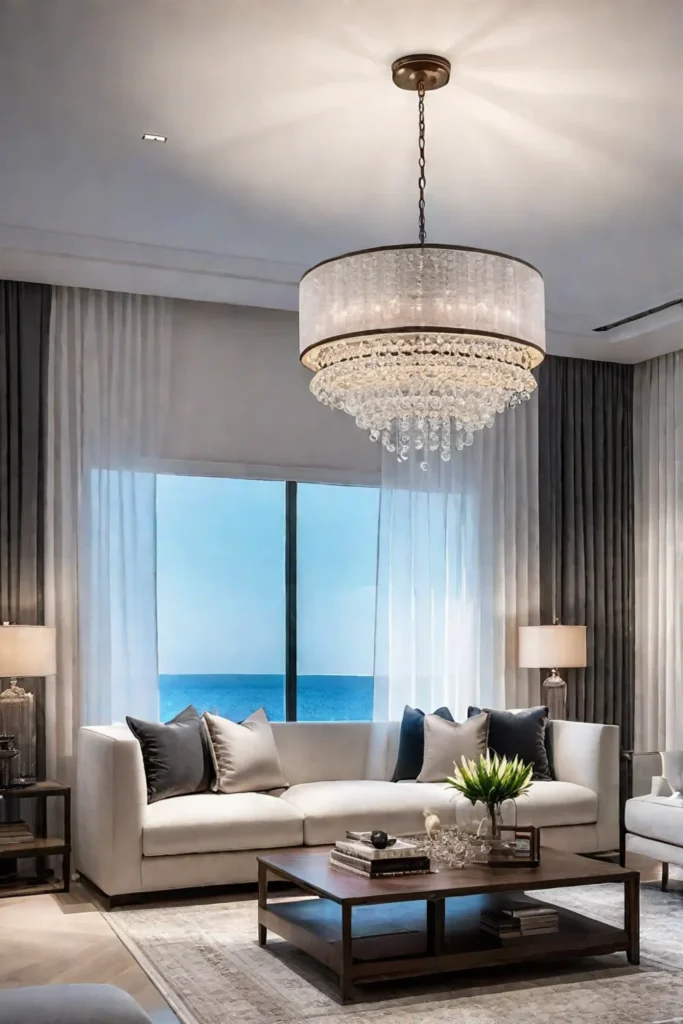
Metallic or high-gloss accents, such as a coffee table, side tables, or wall decor, can also contribute to brightness. These reflective surfaces add a sense of sophistication and luminosity while enhancing the impact of both natural and artificial lighting.
When incorporating reflective elements, balancing and avoiding creating an overwhelming or disjointed aesthetic is essential. Carefully select and position these pieces to maximize their impact while maintaining a cohesive and visually appealing design.
Embracing Ambient Illumination
Ambient lighting is the foundation upon which all other lighting layers are built. It creates a warm, inviting atmosphere and sets the overall tone for a space. Ambient lighting in a small living room differs between a cramped, uninviting environment and a cozy, welcoming retreat.

To achieve a warm and diffused ambient glow, consider combining floor lamps, table lamps, and recessed lighting. This layered approach provides ample illumination and creates depth and dimension, making the room feel more spacious.
Incorporating dimmable lighting options is also crucial, as it allows you to control the intensity of the ambient light based on the time of day or desired ambiance. A soft, diffused glow in the evening can create a cozy and intimate atmosphere, while brighter ambient lighting during the day can enhance productivity and functionality.
Integrating ambient lighting with other lighting layers, such as task and accent lighting, striking a harmonious balance is essential. The ambient layer should provide a warm, consistent base upon which the other layers can build, creating a cohesive and visually appealing design.

Brightening with Light-Colored Surfaces
The strategic use of light-colored surfaces can significantly impact a small living room’s perceived brightness and openness. Light-colored walls, floors, and furnishings reflect and amplify available light and create a sense of airiness and spaciousness.
When selecting paint colors or wallpaper, consider light and airy shades that will brighten the walls and create a sense of openness. Soft whites, pale blues, and gentle greens are excellent choices, as they can make a room feel fresh and inviting while enhancing the impact of both natural and artificial lighting.
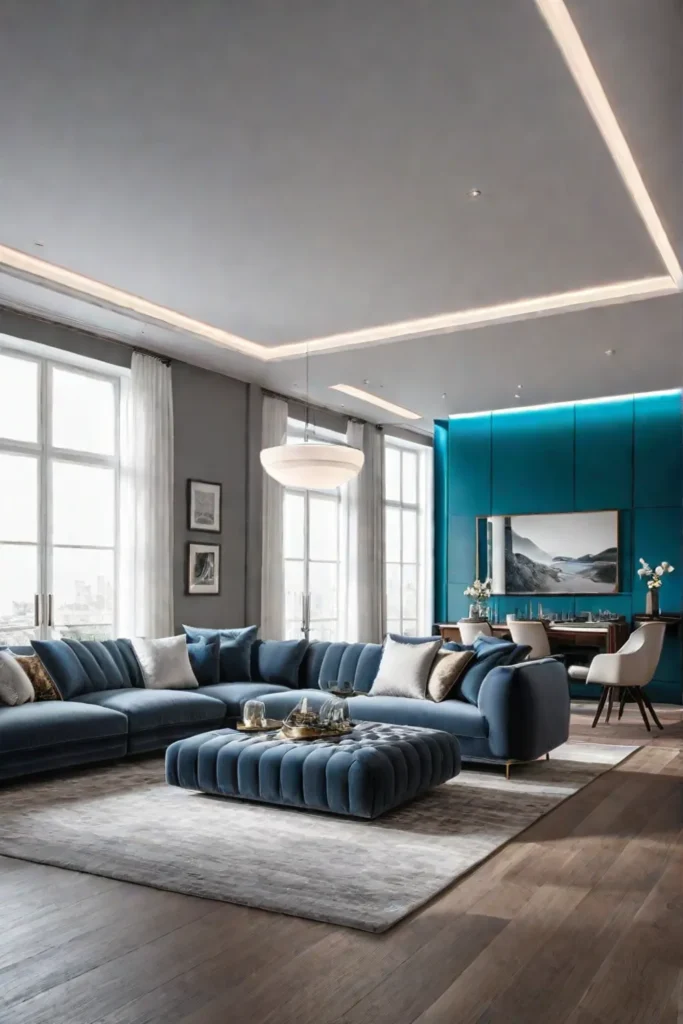
In addition to walls, light-colored area rugs, throw pillows, and other textiles can contribute to the overall brightness while adding softness and texture. These elements reflect light and create a cohesive and visually appealing design.
However, it is important to balance and avoid creating an overly sterile or washed-out environment. Strategically incorporating darker accents, such as rich wood tones or bold artwork, can add depth and visual interest while preventing the space from becoming monotonous.
Balancing Functionality and Aesthetics
It’s essential to balance functional lighting and aesthetic considerations in a small living room. By incorporating both task lighting and decorative light fixtures, you can create a space that looks beautiful and supports the practical needs of daily life.

Task lighting, such as adjustable desk lamps or recessed lighting, provides targeted illumination for specific activities like reading, work, or hobbies. This type of lighting enhances productivity and comfort and allows you to create dedicated zones within the living room, further maximizing the use of the limited space.
Conversely, decorative light fixtures, such as statement pendant lights or sconces, add visual interest and can become focal points within the room. These pieces contribute to the overall aesthetic and draw the eye upward, creating the illusion of height and spaciousness.
When selecting functional and decorative lighting elements, it’s crucial to consider the scale and proportion of the fixtures and the size of the living room. Oversized pieces can overwhelm the space, while undersized fixtures may fail to make the desired impact.
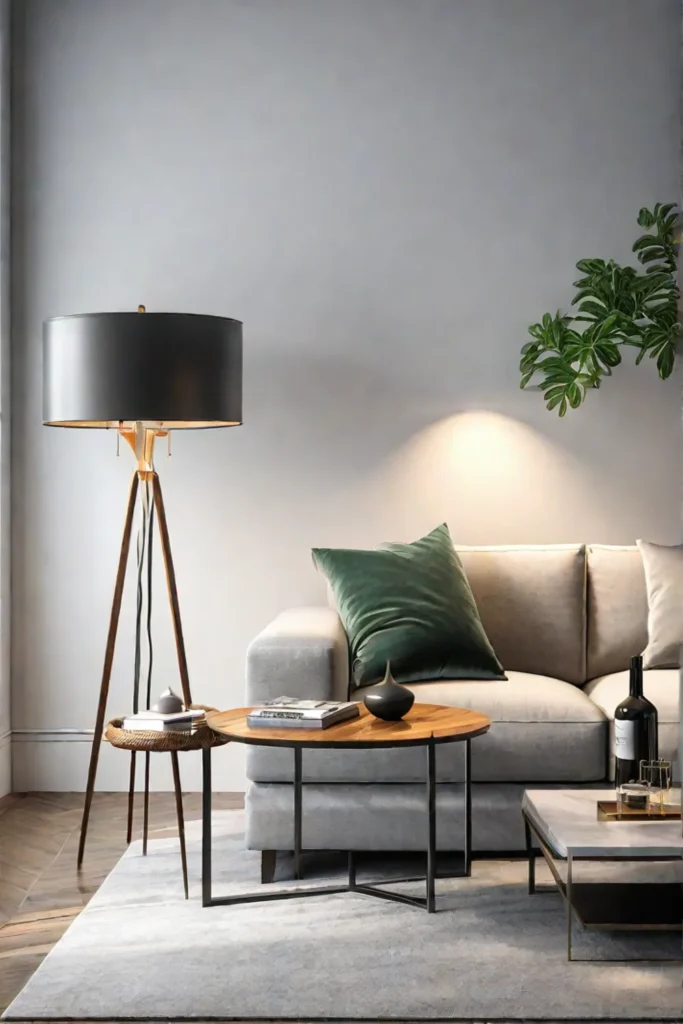
By carefully balancing the functional and aesthetic lighting needs, you can create a visually appealing and practical small living room design that balances form and function.
Conclusion
Lighting is a powerful tool in small living room design, transforming even the most compact spaces into inviting and visually stunning environments. By harnessing the power of natural light, layering artificial illumination, incorporating reflective surfaces, and strategically selecting light fixtures, you can create a space that feels open, airy, and full of life.
Remember, lighting is not just about functionality; it’s an art form that can evoke emotions, set moods, and enhance the overall ambiance of a space. Embrace the possibilities and let your creativity shine through, crafting a living room that meets your practical needs and serves as a sanctuary of comfort and rejuvenation.
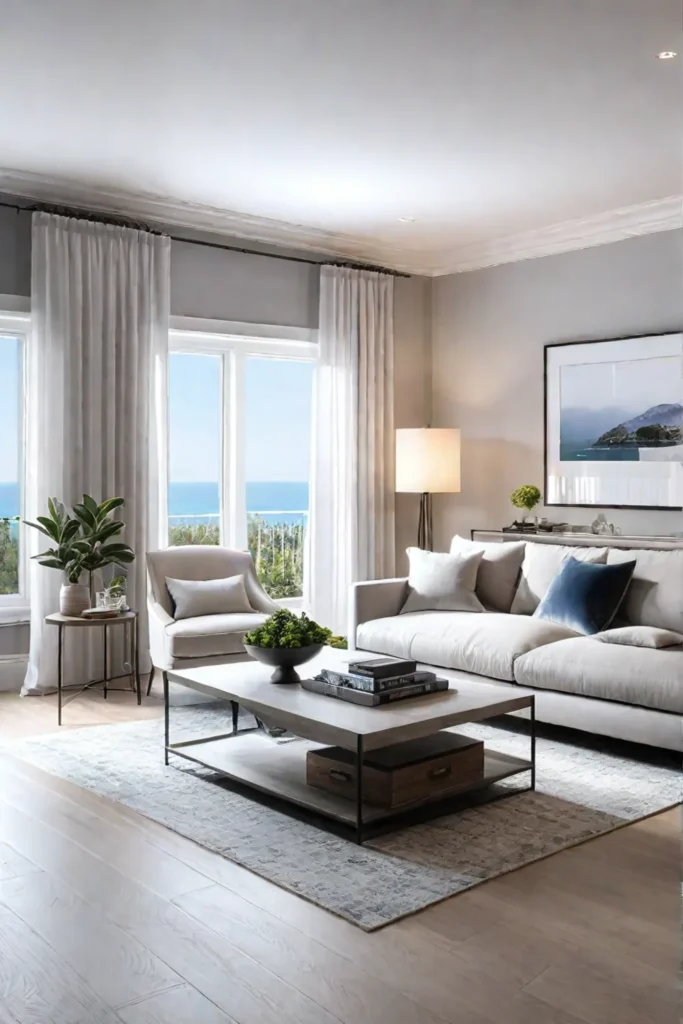
As you embark on your lighting design journey, remember the wise words of the renowned architect Louis Kahn: “A room is not a room without natural light.” By embracing this philosophy and combining it with thoughtful artificial illumination, you can elevate your small living room from a mere space to a captivating and inviting oasis that reflects your style and brings joy to your daily life.




